
A 35mm film and television installation in Únies González’s “Leave the Kitchen Light On”
I met Únies Gonzalez years ago when my best friend and I created the zine and support group formerly known as TULIPS. Since then I’ve seen Gonzalez‘s work in group exhibitions around Houston and have gravitated towards it as a fellow lens based artist myself. When I heard they would be doing something utilizing the entirety of Stinson House, an art space and home located in the Washington Terrace neighborhood of Houston, I was pretty stoked to see what they would come up with. After taking just a few steps into the home to view their photo installation, Leave the Kitchen Light On, I knew I wanted to interview Gonzalez and get to know them and their work a little better.
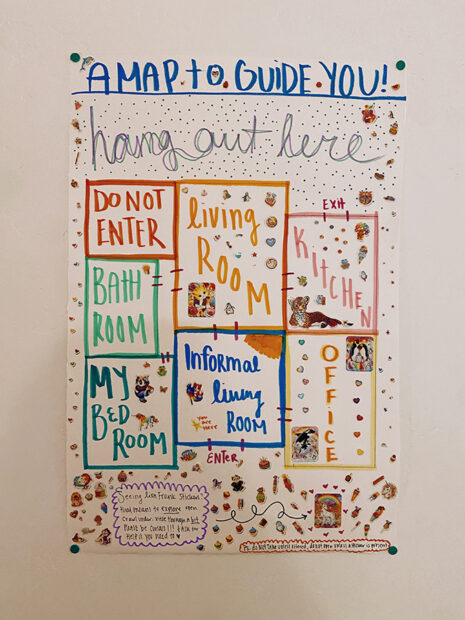
House map as part of Únies González’s “Leave the Kitchen Light On”
Jennifer Battaglia (JB): Should we begin with the basics? You’re a Houston native, correct? Tell us about how you arrived at photography and how long you’ve been documenting everyday moments through the lens.
Únies Gonzalez (UG): God yes, the basics are where comfort lives! I am a Houston native, or at least, for all intents and purposes I am! My parents moved us to Missouri City when I was younger, so I timidly grew up there and then ventured into the loop for family affairs. My aunt and uncle lived in Timbergrove and my grandparents have a tax office off Harrisburg where I spent many a summer. I escaped the ‘burbs at 18 to a little spot off Airline and 23rd Street and have lived in the loop ever since.
I moved closer to town in part because I was going to school at the University of Houston. Originally I was studying psychology, but after a miserable semester my sister encouraged me to switch to photography. I went on to get my BFA in Photo and Digital Media. I started documenting the everyday lazily at 17 (I’m 27 now); my aunt gifted me an Instax for my high school graduation and it made photographing moments more fun. I always reserved film for the more day-to-day type of photographic work.
JB: Beyond your artistic endeavors, do you work elsewhere?
UG: I do work elsewhere! I manage FLATS film lab and play an active part in certain art facilitator roles there as well. I would say I am lucky to have my job, but I worked my ass off to get to where I’m at with it! I’m grateful to work parallel with my medium.
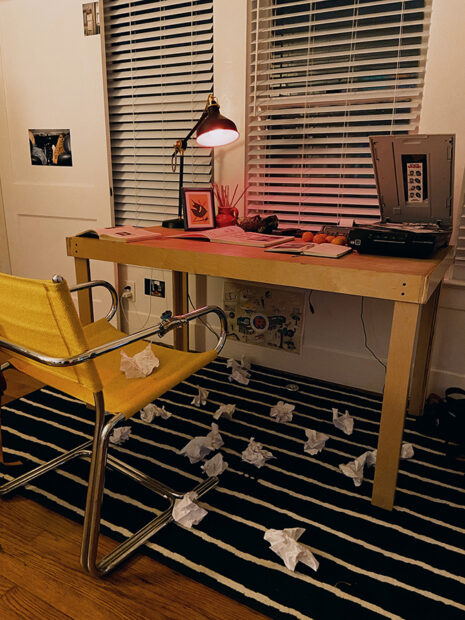
An installation in Únies González’s “Leave the Kitchen Light On”
JB: Which camera(s) do you prefer to use? What about your preferred choice of film? Do you handle the development and printing of all your film yourself?
UG: My cameras have shifted over the years. The 35mm camera that I treasure for life is my Leica M6. I put myself into further debt for that thing as a graduation present. My favorite camera to recommend and the one I really started with is a Canon Rebel 2000; I gave my boyfriend mine in hopes that I could wiggle more photography into his life. For medium format I use a Hasselblad 500C/M; that thing is a mammoth though, so I only take it out for certain occasions.
When it comes to film, I grudgingly choose Portra 400 most frequently. My preference when it doesn’t act up is Ektachrome 100. When I started out, I wanted nothing to do with handling my film on the back end and even still, developing it is just not my thing, [laughs] but I do love scanning it myself. Having full control over the editing results is my favorite and, in my opinion, one of the most important parts. This show was the first time I ever seriously considered the importance of professionally printing my work and I did NONE of it myself!
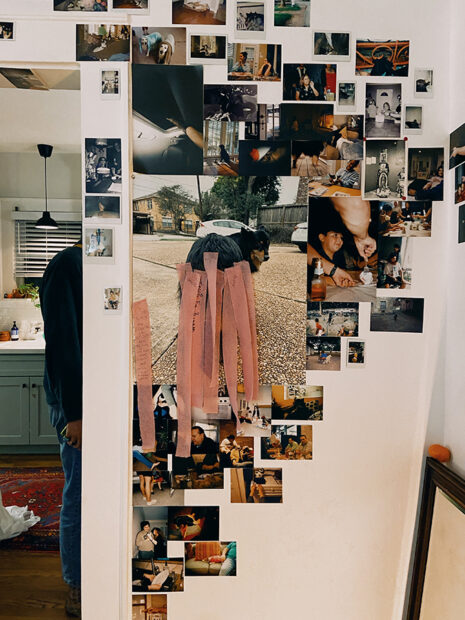
A cluster of photographs in Únies González’s “Leave the Kitchen Light On”
JB: I understand that you collaborated with Jeremy Perez on the Leave the Kitchen Light On photo installation. Had you collaborated with him before this project? Can you tell me about how the project idea came about and what your collaboration process was like?
UG: Jeremy and I met in our PDM program in college and have had a very symbiotic relationship since then. In addition to being someone I collaborate with, he is also one of my best friends and my coworker. In 2019 we co-curated a show called Missed Connections that had an iteration of my dive into immersive work. We are accustomed to working with each other and uplifting one another in our artistic careers. The reason I decided to do the show as a solo show was because of the encouragement of Jeremy and our friend, Cass. After that conversation, I knew with the ideas I had that this was going to take a lot of work, so naturally I asked Jeremy to assist in that process.
Jeremy encouraged me to ask Nick if I could do a show at Stinson House; he carried part of the monumental labor of curating the images that were going to be shown, advocating for ones I would graze over and selecting sizes and potential objects. The blurry lines between my job as an artist and the fact that curation is a huge part of the work I make often makes me a control gremlin of sorts to work with. I give Jeremy all the flowers for being a first responder throughout this process. Working with friends is scary and hard; they often know you best and have a threshold of understanding. His encouragement and eye for unique, specific details are what has made him my collaborative confidant.
The show’s concept came after my obsession with the MoMA show Pleasures and Terrors of Domestic Comfort came to a peak and I started to wonder what domestic photos would look like warmly tucked within the nooks and crannies of a home instead of trapped in a frame on a wall in a gallery. In regards to how collaboration looked throughout this experience, I sincerely believe I was collaborating with every single person who actively assisted in turning the show on: my friend Cristal sat with me on the floor and picked pages from books that mirrored images needing homes; my boyfriend Dillon walked right in and said “this doesn’t feel like our space” and fiddled until it did by adding pieces of himself; my mom and family brought over childhood memorabilia and their own relics; Nick lended me the most generous amount of space in his home and believed in my ideas. That list only scratches the surface of who contributed. While I was very particular about a lot of the installations and specific concepts, so much of the warmth and love felt were added by the hands of those who love me and whom I love, those whose photographs made the show what it was.
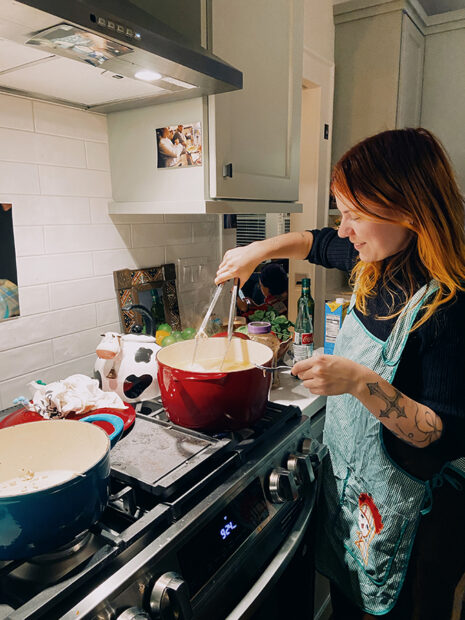
Únies González cooking pozole in the kitchen
JB: When I entered Stinson House, the scent of green chiles immediately hit me, and I couldn’t help but think, “This is exactly right.” Had you cooked there before or after that night when you made pozole? Which, by the way, was delicious! How did it feel to prepare meals in a space filled with traces of your personal life?
UG:I hadn’t cooked there prior, but smells of different variants were a huge part of the show for me! My mom made beans and rice for the preview night and the opening. Watching her cook in Nick’s kitchen and having myself cook in Nick’s kitchen was so silly because I felt like we were all playing house.
Honestly though, it was really nice to be able to utilize the kitchen in such a normal way. I’ve lived in apartments for my entire adult life and being able to cook in a nice, beautiful kitchen that in many ways felt like my own was surreal. I have yet to cook there again, but I do want to one last time.
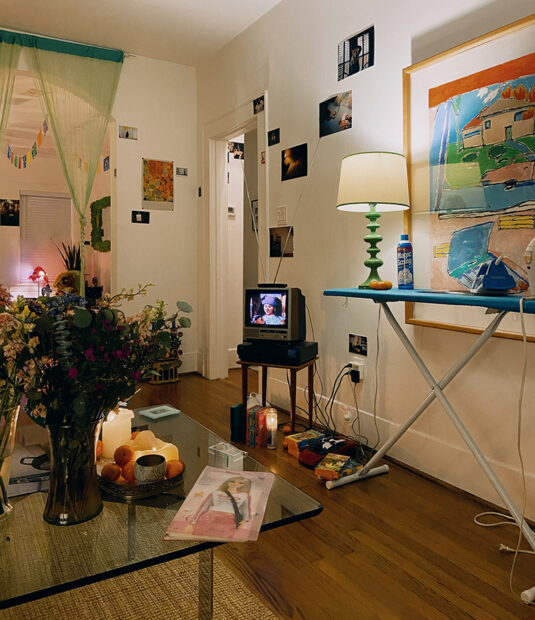
An installation in Únies González’s “Leave the Kitchen Light On”
JB: I found the home to be incredibly welcoming. I visited with a friend I hadn’t seen in a while, and we spent time exploring and absorbing the atmosphere. Yet, amidst this exploration, we also found moments to reconnect and share updates about our lives, all while surrounded by the memories of someone else’s life. Despite the unfamiliarity of the setting, the incorporation of various props and objects lent a sense of familiarity — from the VHS player playing ’90s kids’ TV series to the large bowl of Mexican candy and the nostalgic Barbie photo album that I secretly wished I had. Was creating this inviting atmosphere always part of your intention for the home?
UG: Sincerely, when folks have shared with me stories like yours — stories about the people they had gone to the show with — I feel like everything I was crossing my fingers to happen actually happened. That is exactly how I wanted the show to be experienced. The show and the work in it was an invitation, amongst other things. When I talked about the show throughout its creation, familiarity was a huge point of reference. How does one engage with a stranger’s sense of the familiar? It came down to activating multiple senses: touch, smell, taste, see, hear. We know what they are, sure, but how do we make sure everyone will have at least two happening at once? Studies have shown that smell plays a large part in remembering, so I was very adamant about having multiple and specific types of candles and foods to potentially trigger that.
Also, warm lamp lighting was crucial. I am often disturbed by the hospital-esque, sterile nature of an overhead-lit room. We wanted people to feel comfortable and I was willing to sacrifice some of the work being “well lit” so as to not compromise the overall attempt in enveloping the space in comfort. There is something interesting, in my opinion, about working with outside light and a film photo after the photo has already been taken and printed — how can an image interact further with light? The request for the removal of a visitor’s shoes was additionally an invitation to feel safe, relax, and stay awhile.
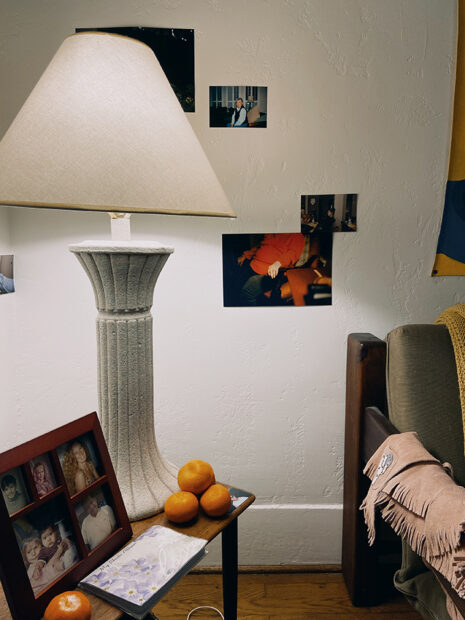
A photo installation in Únies González’s “Leave the Kitchen Light On”
JB: Upon entering the space, the clusters of photographs nestled in the corners of the rooms gave the impression of traversing through another person’s memories. Each room appeared to be a tribute to a particular person or relationship. Could you expand on the creative process behind each room and their associated relationships?
UG: I’m really happy to know that the tribute aspect was translating! The entire show is love letter to the people I cherish most in this life. The rooms were broken into seven parts: the office (friends & family), the informal living room (friends), the formal living room (family), the kitchen (family), the hallway (family), the bathroom (myself), and the bedroom (myself and my boyfriend, Dillon). Each room was characterized by those I felt held the strongest connection to each space. My boyfriend is the only other person I’ve ever shared a bedroom with, so that space was dedicated to him and us. My grandfather has an altar in the office closet because the place he existed most was within his office. The many living spaces are dedicated to both my chosen and blood related families. My dog had sprinkles of himself around the house, like his ever shedding fur. The only room with a dedicated mirror (the bathroom) is an homage to the need for self preservation. There was a lot of intention in creating a dream-like memory landscape, mixing images of all of the listed relationships within those spaces as well, since dreams don’t always happen linearly.
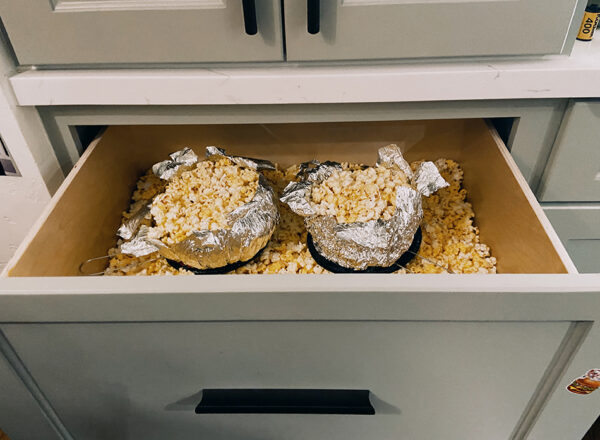
Popcorn in a kitchen drawer in Únies González’s “Leave the Kitchen Light On”
JB: Popcorn and tangelos appeared to be consistent motifs within the installation. Could you share the backstory behind the inclusion of these food items as objects?
UG: You know, I really love this question pairing because I get to say that they are portraits of my mom and dad. My dad is the popcorn, my mom the tangelos. Growing up, a shared treat between my dad and I was popcorn with lime and Tabasco — that is how he always made it and it is, until the day I leave the Earth, my favorite snack. My mom would consistently place one or two tangelos in my school lunchbox. She made my school lunch every morning, and those always found a way inside. They are beautiful and bright orange, and they remind me of her hair. The show functions as a dream; the inclusion of surreal elements was how they manifested in the way they did throughout the home, but their meaning is the love I have for my parents and how they appear to me outside of just their physical form.
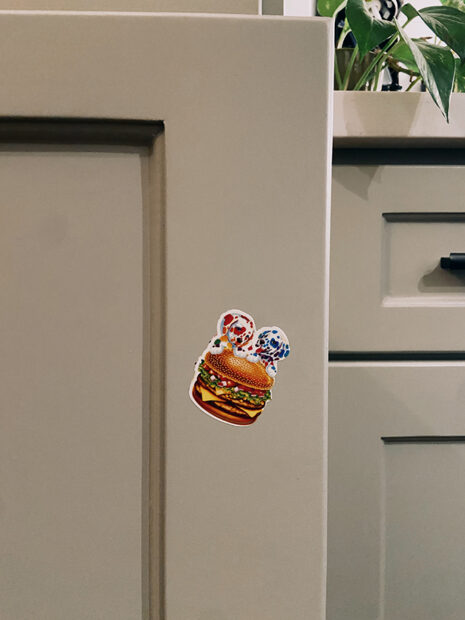
A Lisa Frank sticker on a kitchen cabinet in Únies González’s “Leave the Kitchen Light On”
JB: I had a great time hunting for Lisa Frank stickers. Spotting those vibrant, colorful animals and then uncovering hidden treasures behind closed doors or cabinets added an extra layer of enjoyment to the experience. You and Jeremy really maximized every inch of space brilliantly. Could you share the thinking behind this meticulous approach?
UG: Haha! Oh joy, those stickers. I am a very detail-oriented artist — my boyfriend said to me that I focus on the little details before I focus on the large tasks, but I swear it is because those small things matter MORE than the large. Every inch of that space needed an intentional something. When I said immersive, I meant that in the whole sense of the word. It had to feel like a person was walking into a genuine home. Memories to me are often overwhelming and they come to us in the most random of moments, so the hope was for there to be so much in every nook and cranny that the ignition of a related memory rose in probability. Nick and I spent a lot of time really trying to figure out how to make sure people weren’t distracted by unnatural forces while on their scavenger hunt. Nick recounted a moment of his goddaughter leaving stickers around his house, which ended up being the perfect idea to naturally guide folks.
The stickers were set in place to create both a boundary and an unspoken consent. I was very weary at one point, picturing a Lord of the Flies rampage of childlike curiosity and freedom resulting in chaos if there wasn’t some form of direction. I wanted people to be able to have fun with it too! Eye spy was a game I referenced often when I would explain how I wanted the experience to go; we just gave a bit of a hint on where to look.
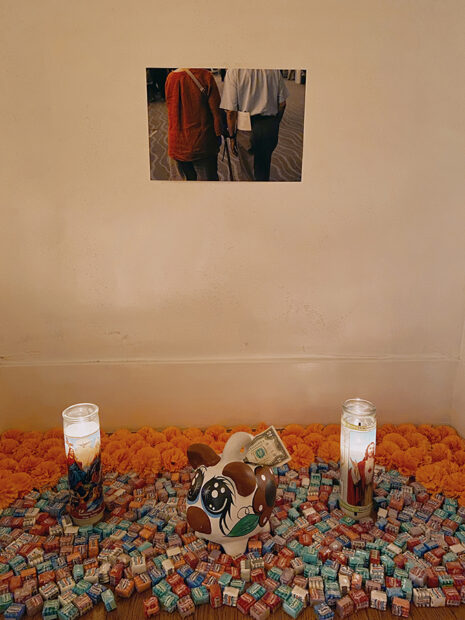
A photograph, Mexican candy, and candles in a closet in Únies González’s “Leave the Kitchen Light On”
JB: Do you have an estimate of the total number of photographs used in the installation? Are you planning to preserve them as they are or will you opt for reprinting, given their placement in soap bottles, filled bathtubs, and toilets?
UG: In total, I wanna say at least 550+ images in all sorts of different forms. I want to preserve them for my own archive, but most of the 5 x 7-inch and below images I am open to reprinting differently for future endeavors. The one in the soap bottle I will retire, along with the one in the mouthwash. That goes for the toilet image as well, I think the image is too painful to really want to utilize again. This could change, but for now I feel pretty firm in letting them have their final resting places.
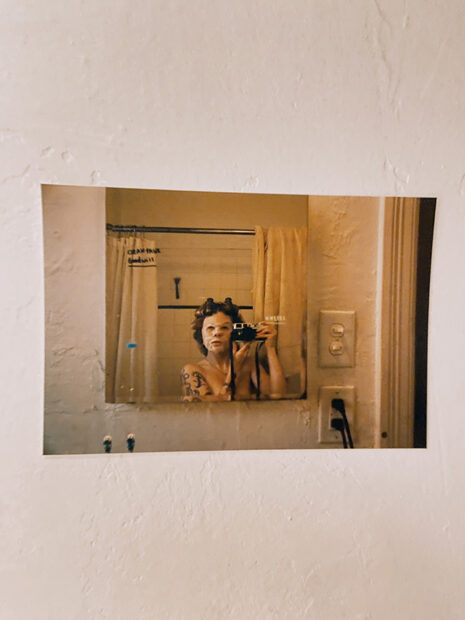
A photograph in bathroom in Únies González’s “Leave the Kitchen Light On”
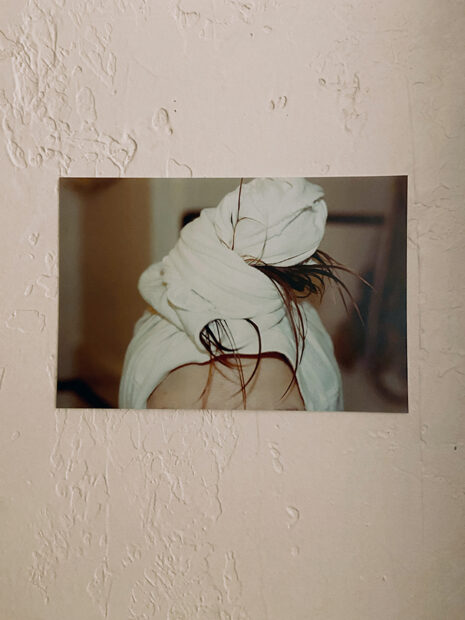
A photograph in bathroom in Únies González’s “Leave the Kitchen Light On”
JB: By the way, could you provide more insight about the photograph in the toilet? I’m curious about the selection of the photo and its placement.
UG: That placement was actually the first placement I thought of when I got the idea for the show! When I started talking to friends about it, most of them were horrified. Some were really weary that having the toilet in use would be disrespectful towards the image placed inside. Though to me, I just saw it as another unexpected place to find a photo. Choosing the photo was interesting, mostly because Jeremy and I knew we didn’t want the image to be of my face, which didn’t leave a lot of options. The selection hit me while scouring all of my files — I had a photo of my banged up knee, a horrible, aching, tense memory from me crashing my boyfriend’s motorcycle four years ago. I hate thinking about that incident and my knee hasn’t been the same since then, so placing a shitty life moment in the toilet just… made sense!
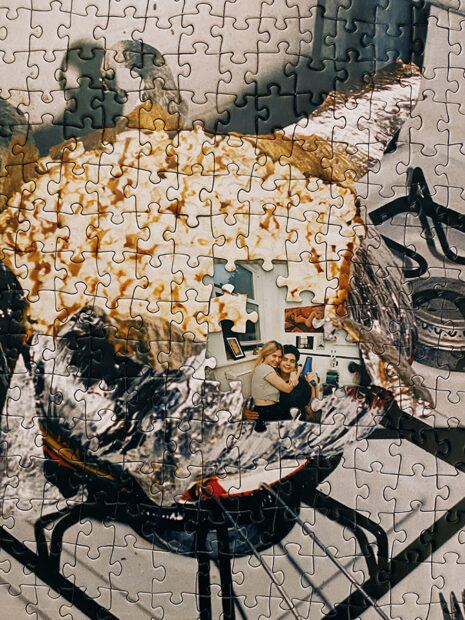
A popcorn puzzle and photograph in Únies González’s “Leave the Kitchen Light On”
JB: What’s next on the horizon for you?
UG: I am currently working on finishing up my first photo book, titled Maybe, Probably, which is chronicling five years with my partner Dillon through various analog formats and writing. Jeremy will be editing that book actually! Really though, I just have a lot of hope for the future, on both fronts. I am a very tenacious person and I want a lot out of this life I am molding for myself. My fingers are crossed two times over for more opportunities to act on and speak on my passions. My toes are crossed that I will continue to have love, in its many facets, in my life.
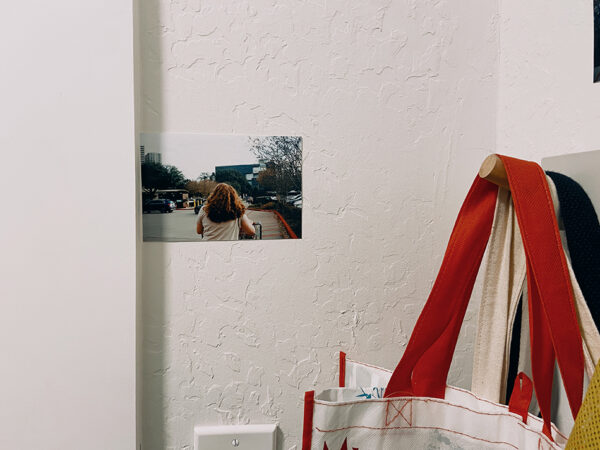
A photograph in the laundry room in Únies González’s “Leave the Kitchen Light On”
Únies González’s Leave the Kitchen Light On was on view at Stinson House (2718 Ruth Street, Houston) from February 24 – March 16, 2024. Stinson House, built in 1940, hosts physical space for friends to exhibit work at all career stages. Stinson House is a collective sharing of resources and does not charge fees or commission. It is lived in and run by Nick Stinson.
Read a review of Leave the Kitchen Light On here.



1 comment
So glad to have experienced this unique opening photo installation, Susan & I really loved it.
Wonderful article too.